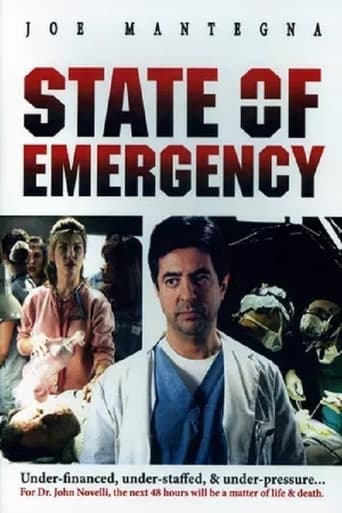

Joe Montegna plays John Novelli, MD, an overstressed emergency-physician whose patient develops an extra-dural hematoma (collection of blood, from the temporal artery, at the high pressure, characteristic of an arterial source) a condition for which trephining (drilling a hole in) the temple of the skull on the affected side is the correct, life-saving treatment to relieve the high, arterial pressure on the brain. It is a very simple procedure, in principle, and does not need a specialist to perform it but liability-risk considerations in this country ordinarily compel the practitioner who diagnoses the condition to refer such a case to a neurosurgeon for the procedure. In the plot, no neurosurgeon is available locally, no helicopter is available to transfer the patient to another hospital, where a neurosurgeon is available. It is a nightmare-scenario. Extradural hematoma is a rapidly fatal condition, for which minutes can make the difference between life and death for the patient, so Novelli has to make a decision fast: let the patient die, unaided, or operate himself. He takes the courageous and potentially life-saving choice, even though he has no neurosurgical privileges, or even any surgical privileges at all, at the hospital. He rallies the ER- and OR-nurses to the effort, scrubs to go into the OR (operating room), sets up the patient for the procedure, sterilizes the overlying skin, sets up a heart-monitor to keep constant of the patient's cardiac status, makes the incision in the skin of the temporal scalp and proceeds to drill the hole in the skull. Before the operation, the patient's heart has slowed, in reponse to the increasing pressure on his brain from the hematoma. After the procedure, the patient's heart returns to normal sinus rhythm, so the operation is a success! Then the patient develops a probably unrelated and unfortunate cardiac arrest. The team attempts resuscitation but fails, so the patient dies, despite the success of the operation, itself. In frustration, a few scenes later, Montegna curses out a nurse over a relative triviality in the view and hearing of the patient's wife. The wife sues the hospital for the death of her husband. She offers an expedient quid pro quo: she will drop the suit if the hospital-trustees will terminate the physician who displeases her. It was an offer they couldn't refuse. The hospital-administrator offers Montegna's character an out: get a letter of resignation on his desk that day and he can make everybody happy. Like the crusader (and fool) he is, Novelli refuses and at the hearing, the trustees predictably whack him for operating without surgical privileges (a cardinal sin in their bureaucratic minds, though that's irrelevant, medically speaking, for the case in question), revoke his emergency-privileges, get rid of him, thus expediently fulfill the disgruntled wife's condition for dropping her lawsuit and get their gold stars for saving the hospital a lot of money. Never mind that they just ruined the career of a crackerjack emergency-physician.
... View MoreA shocking film - though maybe less to non-US audiences - which tells it like it is. Ever wondered what it was like to be a patient, or a doctor, in an overworked, under-staffed, under-funded, under-pressure inner-city public hospital? Well, now you can find out. And it sure ain't ER. Everything about this made-for-TV film screams "authentic" - which probably explains why it has largely disappeared from TV screens and doesn't get the 8+ ratings from the IMDB audience. But it deserves much, much better. The brilliant Joe Mategna plays a zombied-out doctor whose obnoxious couldn't-give-a-shit-manner conceals a man who has reached the end of his tether but is still trying to do the right thing - even in the face of no resources, conniving ass-covering bureaucrats and general public indifference. The ending, and Mantegna's final speech, doesn't quite cut it... but why accentuate the negatives? The setting, ambience and the characters - especially Mantegna - are spot on, and will be instantly recognisable to anyone who has spent much time around a public hospital or the doctors that work there. Compulsory viewing for all medical students who want to know what it's REALLY going to be like. Of course, once they've seen it they may prefer to quit medical school and become lawyers...
... View More